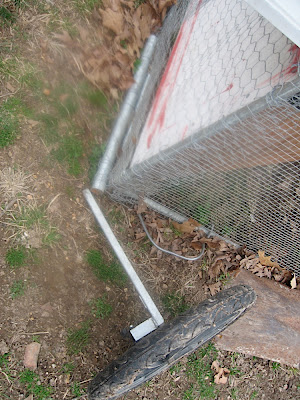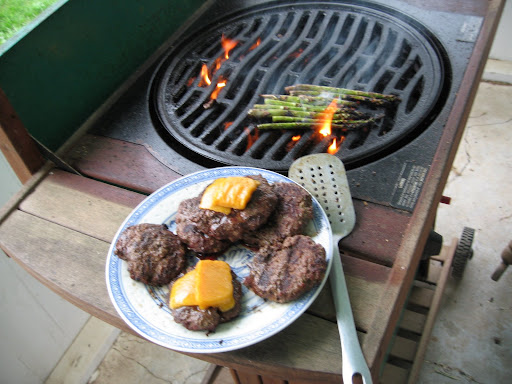A chicken tractor is basically an open-bottomed movable pen that houses chickens. We use our chicken tractors to raise meat birds (Cornish-X broilers). I have a few criteria for our tractor design. First, my pregnant wife must be able to move it easily. Second, it must hug the Ozarks' steep and rocky terrain. Last, it must endure for several years in the weather.

This chicken tractor (plans to follow) was years in the making. I perused several books, searched the internet high and low and consulted with my father-in-law. The final result is simple and elegant. The thing that makes it elegant is that it is light and easy to manage.
My six year old son can move it easily, feed and water them for the day with just one visit. Being based on electrical conduit was my father-in-law's idea and the cornerstone of this tractor. Electrical conduit -also called EMT (Electrical Metallic Tubing)- is inexpensive. This chicken tractor uses 1/2" EMT and cost us around $100. EMT is galvanized and should last for upwards of ten years in the caustic chicken raising environment. People have asked me why I don't use PVC pipe. It won't hold up in the direct sun, it is heavier and isn't as strong as EMT. I also considered pressure treated wood but rejected it because it is treated with poison and chickens will try to eat anything. I don't want to eat pressure treated wood even once removed.
The dimensions of our chicken tractor are 8' by 10' by 2' high. These dimensions are to optimize the materials--EMT comes in 10' lengths. Normal chicken wire comes in 4' widths and hardware wire mesh comes 2' wide. This size also fits through our farm gates and maneuvers through our small paddocks easily. People have made narrower versions of this tractor with great success.
Some of what our tractor is made from is found materials; I collect stuff. We live fairly near an attraction that supports plenty of billboards. Billboard tarp is a godsend. We use it everywhere and it is almost free. Chickens need shelter from the hot sun and rain. Billboard tarp is our answer. You'll need to find a similar solution. Lumberyards usually have surplus lumber tarp.
The poultry fountain and feeder are both items that I spent a lot of effort optimizing. I built the hopper-style feeder from found parts. That is a topic for another day. The poultry fountain is
commercially available but needs simple plumbing to make it really useful for an uneven terrain chicken tractor.
The tractor parts list- 13 pieces of 1/2" electrical conduit EMT
- 8 pull able 90°s for the 1/2" EMT
- 100' of 12 to 16 gauge galvanized steel wire.
- 37' of 1/2" squares hardware wire cloth
- 21' of 48" wide standard chicken wire (the smaller holes)
- 30" length of steel roofing 30" by 3'
- 98" length of 1" EMT the axle bushing
- 2 wheels with axle extending one foot out one side of each wheel
- a handful of 1-1/2" self tapping metal screws I like the kind that have a 5/16 nut driver head.
- tarp UV stable 5' by 8' or larger. has to be a rip stop type of material.
tools list
- flat head screw driver
- hack saw
- linesman pliers
- variable speed electric drill
- drill bit sized to pre-drill for the outside diameter of your metal screws. just a little bigger than your screws.
- magnetic 5/16" nut driver bit to fit your drill
- 1/2" EMT pipe bender
- six year old helper optional
The concept of this tractor is to be flexible and light weight. It needs to follow the contour of the terrain. That is why 1/2" EMT is better than any larger size.
The first step is to take apart the EMT 90°s. Save all the plates and screws, you'll need them later. This is a good job for a six year old. Then, drill out a hole in the exact center of each removed plate from the 90°s.

Cut eight of your ten foot lengths of EMT, two feet off each one. You should end up with eight 2' pieces and eight 8' pieces of EMT. Assemble two rectangles 8' by 10' using the EMT and pullable 90°s. This is also a good job for a 6 year old. Hand tighten each corner firmly--you'd better double check your helper.

Especially since he was only five in this photo.
Mark four of your 2' pieces of EMT in the exact same spot at both ends. You can do this by holding the EMT firmly on a flat surface and marking the top. This step helps keep things lined up. Attach one removed plate to each end of all four pieces of 2' EMT (the corners). They should be 1/2" away from the ends. The self tapping screw can drill right through the EMT without pre-drilling. I put the little escutcheon of the plate facing the head of the screw. Just make them all look the same.

Reassemble the plates (corners) to the 90°s this forms the box shape of the tractor. Five gallon buckets are helpful to keep the other three corners off the ground when first starting.

Cut one inch off the four remaining 2' pieces of EMT (the side supports are 23" long). Make four more side support pieces from the remaining 10' piece of EMT.
Let the drilling begin. Mark and drill holes on every end of each piece of remaining EMT minus one of the 8' pieces. these must all be drilled on the same plane so be sure to use the marking method described earlier. The holes should be large enough that a piece of your 12 gauge galvanized wire fits easily through. Pieces to be drilled should include:
- one 10' piece
- three 8' pieces
- eight 23" pieces
Wire this baby together. The 10' piece gets wired to bisect the top first. Wire it by threading the wire through the hole and wrapping the other pipe and twisting them tight. It is clunky at first but you'll get really good at it. Each wired spot should make a perfect "T". Wire the three 8' cross supports above the 10' on the top at 30", 60" & 90" respectively. Make everything parallel to the edges. Wire the the cross over points together too--wrap twist snip twist some more.

The center needs a support in case any kids or dogs decide to climb on top of it. I bent the remaining piece of eight foot EMT 90° and held it to an edge and cut the tails off. The tails make good handles. Then I wired it to the center support like a swing using the wiring method above. When the tractor is moved it slips around obstacles and rights itself at final resting place to act as support (see second photo below).
Wind protectionCut the tarp into strips 2x(8' by 30") or one long strip 16' by 30". Choose an end of the coop to have the door and all the heavy stuff. Wrap this end with the tarp leaving the extra width on the bottom to act as a skirt when moving it. The wind break/skirt should cover the entire door end and wrap evenly along the sides. Wire this in several places to the top and bottom. Slightly thinner gauge wire can be used for the tarp covering if you have it.
 Hardwire
HardwireWire the hardwire/hardware cloth to the perimeter, overlapping any joints. Wire this securely every foot or so and doubly at the corners. This is your main defense so don't cut any corners here because regular chicken wire won't defend against raccoons.
 The top
The topStretch and cut the chicken wire to the top. Leave a rectangle on the door end open for the door. Wrap a little extra length around the EMT at the perimeter ends and door. The wire should join at the center cross support. Wire it together and to the 10' cross support frequently--every 6 to 10 inches.
The door
I use a piece of steel roofing material for the door. Hinges are made of wire.
The door, feeder and water should all be on one end--the heavy end. I have a set of small wheels with axles from a kids bicycle trailer. I wired a piece of one inch conduit in such a way to receive the wheels.

I lift each corner by wire handles and slip the wheels on.

If you don't have extremely heavy gauge wire for handles you can thread a stub of EMT less than 12 inches long. This photo shows a threaded bent handle at the move-around end.

Once the wheels are on the entire thing moves around like a wheelbarrow. The chickens follow along and are happy to dig-in to the newly exposed area. It is amazingly light, anyone can move it, even a six year old. This feature is surprisingly important since during the last few weeks of occupancy it is best if you move them twice per day. I find that if I have to muster my courage to attempt farm chores they easily slip to the back burner until just shy of too late. We raise twenty five broilers twice per year per chicken tractor--we have two of them.
The wonders, benefits and sustainability of chicken tractors are the subject of a few books. Here are a couple of them.
Pastured PoultryChicken Tractor: The Permaculture Guide to Happy Hens and Healthy Soil








